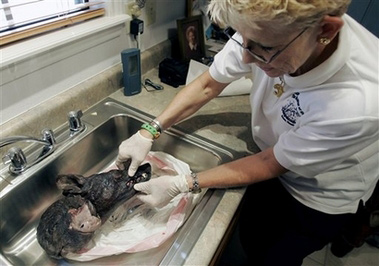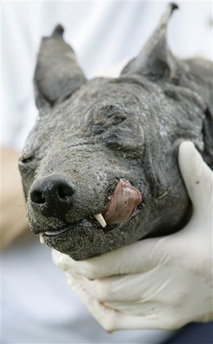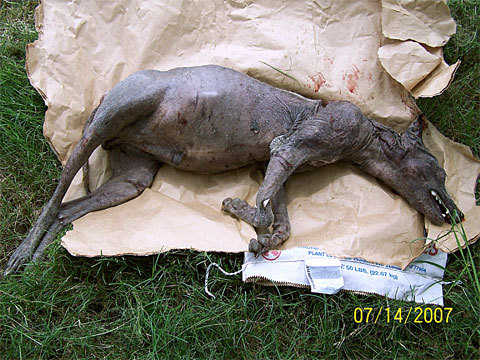
Phylis Canion and her dead head are all over the internet and the media today. Is it a Chupacabras? The answer may rest soon in a lab in Maine.
September 1, 2007

Phylis Canion and her dead head are all over the internet and the media today. Is it a Chupacabras? The answer may rest soon in a lab in Maine.
Perhaps Ms. Canion will read this or someone in authority in Texas shall – and they will contact me. I was telephoned tonight by Dr. Irv Kornfield, Professor of Biology and Molecular Forensics, at the University of Maine, who was helpful in running the DNA samples on last summer’s “Maine Mutant” carcass. Dr. Kornfield has volunteered to run DNA tests on this new Cuero specimen, and I shall be attempting to obtain a sample for him. Ms. Canion, your phone is busy. Please contact me via editor@Cryptomundo.com to get your DNA tests done. No shipping costs to you.



No two ways about it. There’s lots of interest being generated by the new photographs above (all by Eric Gay) added to a recent two-month-old story, renewed, of Phylis Canion’s “Chupacabras” of Cuero, DeWitt County, Texas.
As you may recall, in July 2007, the pictured animal (see directly below) was hit by a car and killed on Phylis Canion’s property, on Buenger Road off U.S. Highway 183 south of Cuero, Texas. Canion had said she saw this “animal” for two years roaming her property.

(Phylis Canion/Contributed Photo)
As Craig Woolheater and I mentioned at the time, the original photographs strongly resembled the Elmendorf Beast. See photographs of the Elmendorf carcass below.


In May, 2004, Elmendorf, Texas farmer, Devin McAnally, shot an animal that was eating berries on his property, and he thought it might be the creature that had been bothering his chickens. Photographs of the hairless, gray, weathered carcass circulated on the internet as a possible Chupacabras. Examination of the remains and the photographs clearly showed that the animal was a canid, suffering with sarcoptic mange caused by scabies. The Sarcoptes scabiei (variety canis) mites burrow and lay eggs under the skin of the animals, with massive hair loss spreading to the entire body.
So what was the “new” 2007 Chupacabras of Phylis Canion’s? DNA tests were to be run at Texas A&M in July. What were the results?
Was this the storied Chupacabras? Or another coyote, fox, or dog with mange?

I had seen one three or four times on our place, but it’s very elusive. So, when I got the call that one had been killed, I got it and took it back to the house. It’s a strange-looking animal. It has short front legs and longer back legs. The paws on the front are different than the ones on the back, and it has no hair. The nose is very long. The tip of the nose is longer than the lower jaw, and the front teeth stick out, almost like fangs.
They are the ugliest things I have ever seen in my life. I don’t know if it was related or not, so I began to set a chicken out at night.
I would find the chicken the next day with all the blood drained out. The carcass was left behind. The scariest thing that happened was the day I found the chicken on my back porch. All the blood was sucked out, and there was not one drop of blood on my porch.
Others I have talked to have seen it, too. But they didn’t tell anyone because they were afraid people would think they are crazy.Phylis Canion, July, 2007.
Now on September 1, 2007, this new Associated Press dispatch about the story, with Canion holding the animal’s head, has zoomed around the world. I’ve been contacted by people I haven’t heard from since I was in graduate school (including a Dean) and many, many others asking me if I’ve seen the article.
For some reason if you google Chupacabras, oftentimes you come up with Coleman too. 🙂 [Part of the joke here is that Coleman, Texas, has infrequently been linked to these “found” mysterious gray Chupa-canid carcasses as well as your humble Cryptomundo cryptozoologist.]
Of course, I couldn’t miss the article and I watched it spread. Written by Elizabeth White with those compelling photographs (up top) by Eric Gay, the piece has everyone talking about Chupacabras again.
The article says little that is new to the story since July, but firmly quotes the owner of the carcass as saying “Canion believes she may have the head of the mythical, bloodsucking chupacabra.”
It furthermore quotes Canion as saying the animal may have killed as many as 26 of her chickens in the past couple of years.
One thing is for certain, writer White is correct to say this Chupacabras has “captured the imagination of locals, just like purported sightings of Bigfoot or the Loch Ness Monster have elsewhere….[for] the discovery has spawned a local and international craze. Canion has started selling T-shirts that read: ‘2007, The Summer of the Chupacabra, Cuero, Texas,’ accompanied by a caricature of the creature. The $5 shirts have gone all over the world, including Japan, Australia and Brunei.”
If everyone has a fun time with it, we’ll keep doing it. It’s good for Cuero.Phylis Canion, quoted by the AP on September 1, 2007.
So contact me, Ms. Canion, and I’ll get your sample tested for DNA, free, at one of the best labs in the world for such analyses. The testing is done openmindedly, with strict scientific rigor.

[Footnote: Unfortunately the AP’s Elizabeth White used incorrect terminology once again, employing the improper Anglo-singular “Chupacabra,” instead of the proper Spanish “Chupacabras” for both single and multiple animals.]
About Loren Coleman
Loren Coleman is one of the world’s leading cryptozoologists, some say “the” leading living cryptozoologist. Certainly, he is acknowledged as the current living American researcher and writer who has most popularized cryptozoology in the late 20th and early 21st centuries.
Starting his fieldwork and investigations in 1960, after traveling and trekking extensively in pursuit of cryptozoological mysteries, Coleman began writing to share his experiences in 1969. An honorary member of Ivan T. Sanderson’s Society for the Investigation of the Unexplained in the 1970s, Coleman has been bestowed with similar honorary memberships of the North Idaho College Cryptozoology Club in 1983, and in subsequent years, that of the British Columbia Scientific Cryptozoology Club, CryptoSafari International, and other international organizations. He was also a Life Member and Benefactor of the International Society of Cryptozoology (now-defunct).
Loren Coleman’s daily blog, as a member of the Cryptomundo Team, served as an ongoing avenue of communication for the ever-growing body of cryptozoo news from 2005 through 2013. He returned as an infrequent contributor beginning Halloween week of 2015.
Coleman is the founder in 2003, and current director of the International Cryptozoology Museum in Portland, Maine.
Filed under Breaking News, Chupacabras, Cryptid Canids, Cryptotourism, CryptoZoo News, Cryptozoologists, Cryptozoology, Evidence, Forensic Science, Media Appearances, Photos, Pop Culture